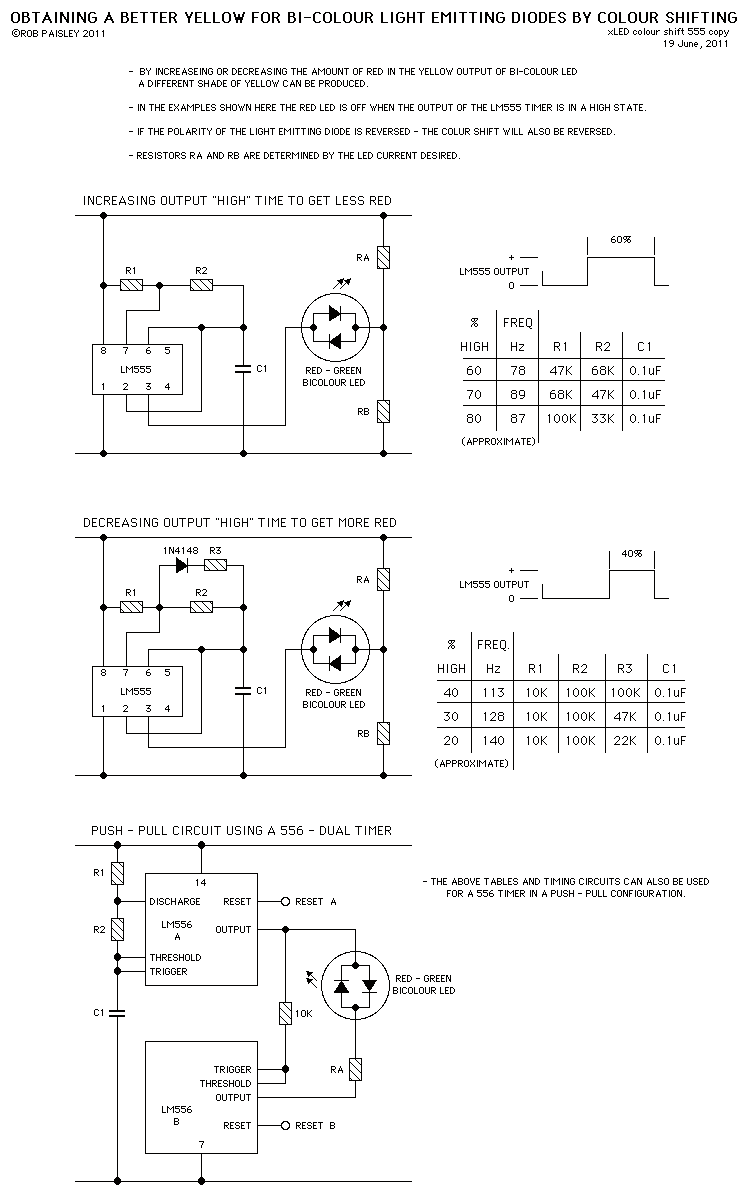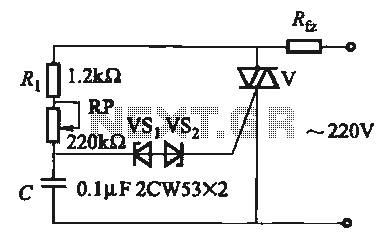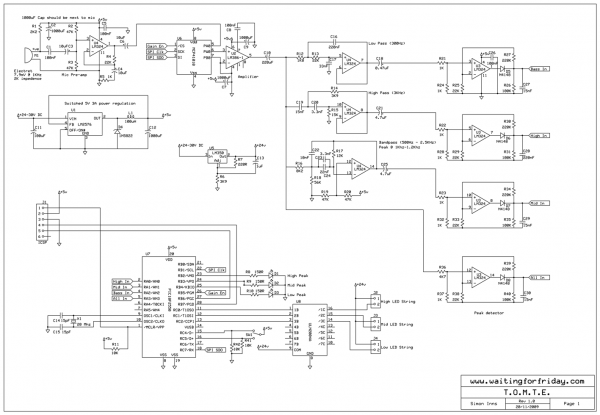
Colour Shifting LED`s

These circuits provide a means of altering the YELLOW output of RED / GREEN type two colour light emitting diodes. These circuits use the LM555 timer chip.
The circuit described utilizes the LM555 timer integrated circuit (IC) to modulate the output of two-color light-emitting diodes (LEDs) that can emit red and green light, producing a yellow output when both colors are combined. The LM555 timer can be configured in various modes, such as astable, monostable, or bistable, depending on the desired effect for altering the YELLOW output.
In a typical configuration, the LM555 timer is set up in astable mode to create a pulse-width modulation (PWM) signal. This PWM signal can control the brightness of the red and green LEDs, allowing for a dynamic range of yellow shades. The frequency and duty cycle of the PWM can be adjusted by selecting appropriate resistor and capacitor values connected to the LM555 timer.
For instance, to achieve a desired frequency, resistors R1 and R2, along with capacitor C1, are chosen based on the formula for the frequency of an astable circuit:
\[ f = \frac{1.44}{(R1 + 2R2) \cdot C1} \]
The duty cycle, which determines the ratio of the "on" time to the total cycle time, can be modified by varying the values of R1 and R2. A higher duty cycle will result in a brighter yellow output, while a lower duty cycle will dim the output.
The output of the LM555 timer can be connected to a transistor or a MOSFET to drive the LED load, ensuring that the current and voltage ratings of the LEDs are not exceeded. This arrangement allows for efficient control over the LED operation while providing sufficient current to achieve the desired brightness.
This circuit can be used in various applications, including decorative lighting, indicators, and displays, where the ability to control the color output dynamically is advantageous. Proper thermal management should be considered to prevent overheating of the LEDs during prolonged operation.These circuits provide a means of altering the YELLOW output of RED / GREEN type two colour light emitting diodes. These circuits use the LM555 timer chip. 🔗 External reference
The circuit described utilizes the LM555 timer integrated circuit (IC) to modulate the output of two-color light-emitting diodes (LEDs) that can emit red and green light, producing a yellow output when both colors are combined. The LM555 timer can be configured in various modes, such as astable, monostable, or bistable, depending on the desired effect for altering the YELLOW output.
In a typical configuration, the LM555 timer is set up in astable mode to create a pulse-width modulation (PWM) signal. This PWM signal can control the brightness of the red and green LEDs, allowing for a dynamic range of yellow shades. The frequency and duty cycle of the PWM can be adjusted by selecting appropriate resistor and capacitor values connected to the LM555 timer.
For instance, to achieve a desired frequency, resistors R1 and R2, along with capacitor C1, are chosen based on the formula for the frequency of an astable circuit:
\[ f = \frac{1.44}{(R1 + 2R2) \cdot C1} \]
The duty cycle, which determines the ratio of the "on" time to the total cycle time, can be modified by varying the values of R1 and R2. A higher duty cycle will result in a brighter yellow output, while a lower duty cycle will dim the output.
The output of the LM555 timer can be connected to a transistor or a MOSFET to drive the LED load, ensuring that the current and voltage ratings of the LEDs are not exceeded. This arrangement allows for efficient control over the LED operation while providing sufficient current to achieve the desired brightness.
This circuit can be used in various applications, including decorative lighting, indicators, and displays, where the ability to control the color output dynamically is advantageous. Proper thermal management should be considered to prevent overheating of the LEDs during prolonged operation.These circuits provide a means of altering the YELLOW output of RED / GREEN type two colour light emitting diodes. These circuits use the LM555 timer chip. 🔗 External reference





